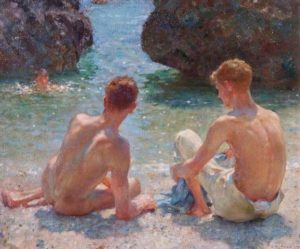 In celebration of fifty years of the partial decriminalisation of homosexuality Tate Britain’s exhibition looks at ‘Queer’ British art from 1861 to 1967. We went along last Friday.
In celebration of fifty years of the partial decriminalisation of homosexuality Tate Britain’s exhibition looks at ‘Queer’ British art from 1861 to 1967. We went along last Friday.
I wondered just what form the exhibition would take, would it be paintings of ‘queer’ subjects, (to use the exhibition’s own word) or of art by ‘queer’ artists? Can there be said to be a ‘gay’ sensibility, or an overtly ‘queer’ art movement?
Given that art is created by individuals, if the artist is ‘transgressive’ in any way, sexually, or politically for example, that is likely to inform his or her creations. Indeed it could be said that the best artists are, by their nature, outside the common run. Art and artists also feed on what is around them and, it is clear from the exhibition, there were known ‘gay’ groupings, even though criminal at the time. One would expect this, or at least some of it, to inform the art.
Does it? Well, yes and no.

As the exhibition makes clear any obvious expression of transgressive sexuality was impossible in the Victorian era. I was surprised to learn that, until 1861, ‘sodomy’ carried the death penalty. Even after that date imprisonment with hard labour was the common punishment, witness the celebrated case of Oscar Wilde, so any expression of a hint of difference had to be encoded. Thus we have classical subjects for paintings, beautiful young men at their exercise in gymnasia, languid and tactile, beautiful, half-clad women. A short step from Sir Laurens Alma-Tadema (hetero) to Simeon Solomon (not). Solomon’s painting of Sappho and Erinna is in Room 1. He was a Pre-Raphaelite painter I knew little about, not surprising as, after he was caught in flagrante with another man he was imprisoned and his reputation destroyed. I particularly enjoyed his drawings, but there weren’t many of his paintings on show.
Room 2 goes from the 1880s to 1928 and the obscenity trial of Radclyffe Hall’s The Well of Loneliness. While Rooms 3, 4 and 5 look at the areas of late nineteenth and early twentieth century society in which there was some freedom of queer expression, albeit veiled. Cross-dressing in the theatre was accepted and ‘theatrical’ became a known euphemism for queer. The avant garde and wealthy progressives were relaxed about sexuality – same sex relationships and open marriage – the Bloomsbury group features strongly here.
 Two world wars, in which women took on new roles and tasted new freedoms (and were enfranchised in 1918) began to change perceptions of gender norms. Painters like Dame Laura Knight challenged the way she was treated, as an artist who happened to be woman. But, even in the 50s and 60s, when Soho in London saw the establishment of queer salons which included Francis Bacon and David Hockney, gay couples still had to maintain the veneer of hetero ‘respectability’. Rooms 6,7, and 8 cover this period, ending with the increasing pressure to change the law which found expression in popular films like ‘Victim‘ and in Bacon’s increasingly overt works (his 1955 exhibition at the ICA was investigated for obscenity).
Two world wars, in which women took on new roles and tasted new freedoms (and were enfranchised in 1918) began to change perceptions of gender norms. Painters like Dame Laura Knight challenged the way she was treated, as an artist who happened to be woman. But, even in the 50s and 60s, when Soho in London saw the establishment of queer salons which included Francis Bacon and David Hockney, gay couples still had to maintain the veneer of hetero ‘respectability’. Rooms 6,7, and 8 cover this period, ending with the increasing pressure to change the law which found expression in popular films like ‘Victim‘ and in Bacon’s increasingly overt works (his 1955 exhibition at the ICA was investigated for obscenity).
The exhibition is broadly chronological in approach and is very good at telling personal stories within the march of history. The web-site continues those stories, see Five Stories of Queer Artists. There are some unusual and amusing works on show, not just painting and drawing. I rather liked the box of naval buttons, one for each ‘conquest’ at a port during the war-time years ( there were over two hundred, my, someone was busy! ). The exhibition doesn’t really seek to explore the question of queer sensibility and art, it is more about documenting the past and how it was for individuals, but I would guess that this question features in the accompanying book – A Queer Little History of Art, at £12.99.
The Tate Britain exhibition runs to 1st October 2017 and costs £15 to enter (concessions available). See web-site for details. It is interesting and worth a visit.
If you enjoyed reading this review you might also enjoy Eric Ravilious America After the Fall Paul Nash Somerset House The Queens House The Life and Death of Miss Dupont


 RSS – Posts
RSS – Posts